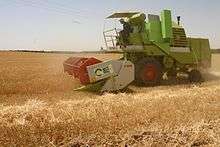Agriculture in Algeria
Agriculture in Algeria composes 25% of Algeria's economy and 12% of its GDP in 2010. Prior to Algeria’ colonization in 1830, nonindustrial agriculture provided sustenance for its population of approximately 2-3 million. Domestic agriculture production included wheat, barley, citrus fruits, dates, nuts, and olives. After 1830, colonizers introduced 2200 individual farms operated by private sectors. Colonial farmers continued produce a variety of fruits, nuts, wheat, vegetables. Algeria became a large producer of wine during the late 19th century due to a crop epidemic that spread across France. Algeria's agriculture evolved after independence was achieved in 1962. The industry experienced multiple policy changes modernize and decry on food imports. Today, Algeria's agriculture industry continues to expand modern irrigation and size of cultivable land.

Despite Algeria's geographical size, less than 4% of its total land area is cultivable. Prior to 1987, all cultivable land was possessed by the state. The state divided this land into sections recognized as the domains agricoles socialistes. These farms were abolished after 1987 and the state sold the cultivable land to individuals. However, the government of Algeria retains control over one third of all cultivable land.[1]
Wine production
Throughout arable lands in Algeria the soil favours the growth of vines. The country, in the words of an expert sent to report on the subject by the French government, "can produce an infinite variety of wines suitable to every constitution and to every caprice of taste".
The growing of vines was undertaken early by the colonists, but it was not until vineyards in France were attacked by phylloxera that the export of wine from Algeria became significant. In 1883, despite precautionary measures, Algerian vineyards were also attacked but in the meantime the quality of their wines had been proved. In 1850, less than 2,000 acres (8 km²) were devoted to the grape, but in 1878, this had increased to over 42,000 acres (170 km²), which yielded 7,436,000 gallons (28,000 m³) of wine. Despite bad seasons and ravages of insects, cultivation extended, and in 1895, the vineyards covered 300,000 acres (1,200 km²), the produce being 88,000,000 gallons (333,000 m³). The area of cultivation in 1905 exceeded 400,000 acres (1,600 km²), and in that year the amount of wine produced was 157,000,000 gallons (594,000 m³). By that time the limits of profitable production had been reached in many parts of the country. Practically the only foreign market for Algerian wine is France, which in 1905 imported about 110,000,000 gallons (416,000 m³).
The Algerian body responsible for wine cultivation is called the National Office of Marketing of Wine Products (ONCV).
References
- Nations Encyclopedia, Algeria
- Kielstra, Nico (1978). "The Place of the Agrarian Revolution in the Algerian Approach to Socialism". Social Scientist. 7 (1/2): 69–89. doi:10.2307/3516768. JSTOR 3516768.
- https://www.jstor.org/stable/3516768?seq=2#metadata_info_tab_contents, 71.
- The Evolution of Colonial Agriculture: The Creation of the Algerian "Vignoble," 1870-1892 Author(s): Kolleen M. Cross Source: Proceedings of the Meeting of the French Colonial Historical Society, Vol. 16 (1992), pp. 57-72 Published by: Michigan State University Press Stable URL: https://www.jstor.org/stable/42952238 57.
- The Challenge of Agriculture in Algeria: Khaled and Masahiro 65 – 71 https://home.hiroshima-u.ac.jp/food0709/seika/seika2012-3.pdf
- The Challenge of Agriculture in Algeria: Khaled and Masahiro 65 – 71 https://home.hiroshima-u.ac.jp/food0709/seika/seika2012-3.pdf
- The Resources of the Third World by Guy Arnold Routledge Taylor &. Francis Group LONDON AND NEW YORK 1997
- "Algeria - Livestock".
- "Algeria adopts measures to boost investment and increase production in agriculture | Algeria 2017 | Oxford Business Group".
Benmehaia, M. A., & Brabez, F. (2016). THE PROPENSITY TO COOPERATE AMONG PEASANT FARMERS IN ALGERIA: AN ANALYSIS FROM BIVARIATE APPROACH. International Journal of Food and Agricultural Economics, 4(4), 79-92. Retrieved from https://search.proquest.com/docview/1851600757